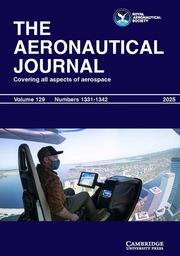No CrossRef data available.
Article contents
Numerical simulation on the influence of aerothermodynamics on forward-facing cavities in hypersonic rarefied flow
Published online by Cambridge University Press: 17 June 2025
Abstract
The cavities over the re-entry vehicle alter the aerothermodynamic properties, leading to enhanced thermal protection as well as effective aerothermodynamic performance. This paper investigates the estimation of aerothermodynamic properties over a re-entry vehicle with different types of cavities on the frontal face of the vehicle. The direct simulation Monte Carlo (DSMC) simulation of hypersonic flow over the Crew module Atmospheric Re-entry Experiment (CARE) capsule was simulated with the re-entry velocity of 7,422 m/s and the freestream temperature of 225 K at an altitude of 110 km. A transient flow Knudsen number of 0.1 and air consists of 78.09% of  ${N_2}$ and 21.91% of
${N_2}$ and 21.91% of  ${O_2}$ are used in the simulations. Two types of cavities, namely trapezoidal and the semi-circular cavity on the frontal face of the re-entry vehicle with different length to depth ratios, are analysed. The simulation results show that the recirculation regions are formed at the base of the cavity in the case of a cavity with sharp corners, whereas in the case of a cavity with rounded corners, the recirculation formed at the lip of the cavity for both trapezoidal and the semi-circular cavities. Increasing the length and depth of the cavity leads to smaller decrement in the drag when compared to the capsule without cavity for both trapezoidal and the semi-circular cavities. The heat flux is low for a cavity with the small L/D ratio (L/D = 0.5) for both fixed length and depth for trapezoidal-type cavity, whereas for large L/D ratio (L/D = 1.5) increasing the length of the cavity increases the overall heat flux.
${O_2}$ are used in the simulations. Two types of cavities, namely trapezoidal and the semi-circular cavity on the frontal face of the re-entry vehicle with different length to depth ratios, are analysed. The simulation results show that the recirculation regions are formed at the base of the cavity in the case of a cavity with sharp corners, whereas in the case of a cavity with rounded corners, the recirculation formed at the lip of the cavity for both trapezoidal and the semi-circular cavities. Increasing the length and depth of the cavity leads to smaller decrement in the drag when compared to the capsule without cavity for both trapezoidal and the semi-circular cavities. The heat flux is low for a cavity with the small L/D ratio (L/D = 0.5) for both fixed length and depth for trapezoidal-type cavity, whereas for large L/D ratio (L/D = 1.5) increasing the length of the cavity increases the overall heat flux.
Information
- Type
- Research Article
- Information
- Copyright
- © The Author(s), 2025. Published by Cambridge University Press on behalf of Royal Aeronautical Society


